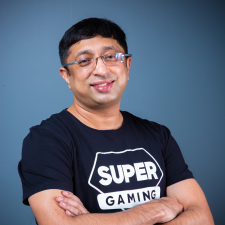With the unbanning of BGMI, it’s become increasingly clear - as players rapidly pick it up once more - that there’s a hunger for games in the battle royale genre in India.
A massive country, and a growing mobile gaming market, as penetration continues it’s only natural that some genres stand out as fan favourites. Battle royale is one of them, and it’s not just imports like BGMI which are making waves.
We recently covered Battle Stars, a regular top-down shooter that’s now jumping onto the battle royale craze. But the same studio behind Battle Stars wants to bring a ground-up Indian battle royale game, Indus, to market, facing down stiff competition but hoping to show what domestic developers can do. With 1.5 million registrations so far, it may just have a chance to do so.
We got the chance to speak to the co-founder and CEO of the studio behind Indus, SuperGaming, Roby John and learn about his views on the Indian mobile gaming market and why battle royale is the big thing in this market.
PocketGamer.biz: So what do you think makes battle royale titles so popular with Indian gamers?
Roby John: Indian gamers gravitated towards battle royales in droves for a host of reasons. For one, it’s a genre that’s easily understood. The core loop of dropping onto a map, looting gear, and surviving is uncomplicated. These games lend themselves well to being a spectator sport that even non-gamers would understand which is why they caught on fairly quickly. This was also crucial in building a foundation for Indian esports and content creation ecosystems that thrive to this day.
Easily understood gameplay aside, a side-effect of battle royales having great voice chat tools meant that players would spend time in-game and in lobbies with friends simply talking about their day or just discussing random topics that aren’t directly related to the game. In a way BGMI and Free Fire ended up being social networks wherein players would get together and hang out while surviving other squads.
Also, you don’t need the latest and greatest in smartphone hardware to have a good enough time playing battle royales, this ensures a certain level of parity, making them played widely across different kinds of audiences.
In a nutshell: by design or otherwise, battle royales are a frictionless entry point for Indians to play games. They have the right mix of easy to grasp gameplay, social networking features, and feature parity. The end result: a thriving audience of 400 million players and counting.
What do you think makes the Indian gaming market, and mobile gaming in the country, unique?
The Indian gaming market is unique in the sense that it’s only hit massive scale with the advent of affordable smartphones and lower data tariffs. Granted there’s been a vocal PC and console culture for years, but it’s a small niche versus what mobile is. At the same time it’s a market that has expectations in line with what gamers in the US or Europe are used to. This makes the market a challenge to build for with discoverability and distribution being crucial. For instance we had seen 15 percent of our audience was Indian until July 2020. Just before the first PUBG/BGMI ban, it was 20 to 25 percent. By mid-2022 it was around 40 to 45 percent. At that point of time we felt we should be promoting our games in the country, which has worked out well through partnerships with the likes of Techno Gamerz — India’s leading gaming YouTuber as well as working with platform holders like Apple, Google and YouTube.
Is this something we could have done in 2020? Perhaps, but it wouldn’t have been as effective. From a business perspective, the critical mass and user feedback from players that kicked in later on was crucial to let us put our best foot forward.
Have recent events, such as the banning of BGMI, made Indian gamers hungry for more battle royale titles?
It’s no secret that BGMI and to an extent Free Fire made the market. Their absence had undoubtedly impacted the overall ecosystem from content creators to esports organisations as well as fans that sprung up to support either game. While this has led other titles like Valorant, Pokemon Unite and Call of Duty Mobile to be thrust into the spotlight, the appetite for battle royale games has remained strong. It's something we see in every playtest. There’s an increase in sign-ups. With the first one in our office in Pune having around 600 sign-ups, the last one we had in Surat had about 2,500 sign ups.
To us, it’s a clear cut indicator that the genre has enduring appeal.
With BGMI coming back, do you see there being any pressure to launch the game or respond to Krafton?
We’re glad it’s coming back. Gaming should be without boundaries. It’s yet another signal that gaming and esports are the biggest opportunities in India and now, it comes with the recognition of the government as well. Hopefully, this jumpstarts Indian talent for a better and bigger games industry across content creation, esports, and of course, game development.
As for us, we don’t believe we’re competing with BGMI. Though PUBG, Apex Legends, and our earlier shooter, MaskGun (which predates BGMI/PUBG) are among other titles that influenced the creation of Indus, the market is big enough for several battle royale games to not just survive, but thrive.






















